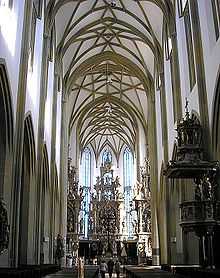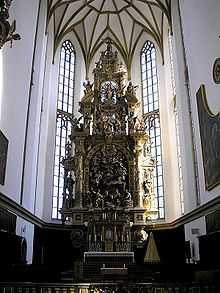St. Ulrich's and St. Afra's Abbey (Augsburg)
| Imperial Abbey of Saints Ulrich and Afra, Augsburg | |||||
| Reichskloster Sankt Ulrich und Afra in Augsburg | |||||
| Imperial Abbey of the Holy Roman Empire | |||||
| |||||
|
| |||||
The abbey of Saint Ulrich and Saint Afra | |||||
| Capital | St Ulrich's and St Afra's Abbey | ||||
| Government | Elective principality | ||||
| Historical era | Middle Ages | ||||
| - | Founded | ca 10th century | |||
| - | Gained immediacy | 1577 | |||
| - | Immediacy accepted by Bp Augsburg |
1643/44 | |||
| - | Secularised to Augsburg (Imp. City) and Bavaria |
1802 | |||
| - | City mediatised to Bavaria | 1803 | |||
| Today part of | | ||||
| a: De jure b: De facto | |||||


St. Ulrich's and St. Afra's Abbey, Augsburg (German: Kloster Sankt Ulrich und Afra Augsburg) is a former Benedictine abbey dedicated to Saint Ulrich and Saint Afra in the south of the old city in Augsburg, Bavaria.
From the late 16th century onward, the Abbey of St. Ulrich and St Afra was one of the 40-odd self-ruling imperial abbeys of the Holy Roman Empire and, as such, was a virtually independent state. The territory of that state was very fragmented: the abbey of St. Ulrich and St Afra proper enclaved within the Free Imperial City of Augsburg, and several small territories disseminated throughout the region. At the time of its dissolution in 1802, the Imperial Abbey covered 112 square kilometers and had about 5,000 subjects.[1]
History
The Benedictine monastery was preceded by an original foundation established at an uncertain date, but at least as early as the 10th century (and in its turn quite possibly a refoundation of a still earlier one from the 5th or 6th centuries), by the "Kollegiatstift St. Afra", a community of the priests charged with the care of St Afra's Church (now the Basilica of Saints Ulrich and Afra), where the relics of Saint Afra were venerated, and next door to which the community premises were built.
Between 1006 and 1012, Bruno, Bishop of Augsburg, removed the canons to the cathedral chapter and gave the premises to Benedictine monks whom he brought from Tegernsee Abbey, thus turning it into a Benedictine monastery. It was granted Imperial immediacy (German: Reichsfreiheit) as an Imperial abbey in 1577, but this status was bitterly contested by the bishops of Augsburg, and the legal conflict was resolved in favour of the abbey only in 1643/44.
The abbey was dissolved in 1802 during the secularisation of Bavaria. The city of Augsburg and the state of Bavaria divided its territory between them. The monks however were permitted to remain in the premises of the dissolved monstery. In 1805 a French military hospital was installed here; after six monks, including the abbot, had died of infectious diseases, the remainder moved into a private house. The hospital was replaced in 1807 by a Bavarian cavalry barracks, known as the "Ulrichskaserne".
The barracks remained here until World War II, when in 1944 the buildings were largely destroyed. The remains were not cleared until 1968–71. On the site the "Haus St. Ulrich" has stood since 1975, an academy and pastoral centre of the Diocese of Augsburg. The sarcophaguses of Saint Afra and Saint Ulrich are preserved in the crypt.
Abbots of St. Ulrich's and St. Afra's Abbey
- Regimbald (c. 1012–15)
- Dego (1015–18)
- Gotstegen (1018–20)
- Fridebold (1020–30)
- Heinrich I (1031–44)
- Tieto (1044–50)
- Adelhalm (1050–65)
- Diemar (1065–80)
- Sigehard (1080–ca 1094)
- Hartmann (1094–96)
- Berengar (1096–1107)
- Adalbero (1107–09)
- Gunther (–1109)
- Egino (1109–20)
- Wollemar (1122–26)
- Udalschalk (1127–51)
- Hezilo (1156–64)
- Ulrich I of Biberbach (1169–74)
- Heinrich II of Meysach (1177–79)
- Manegold (1182–84)
- Heinrich III (1187–90)
- Erchenbold (1193–1200)
- Ulrich II (–1204)
- Heinrich IV of Belsheim (1213–16)
- Dietho (1221–25)
- Luitfrid (1225–30)
- Hiltibrand of Thierheim (1234–41)
- Gebwin of Thierheim (1241–66)
- Dietrich of Rodt (1277–88)
- Sibotho Stolzkirch (1288–92)
- Heinrich V von Hagenau (1292–1315)
- Marquard von Hageln (1316–34)
- Konrad I Winkler (1334–55)
- Johannes I von Vischach (1355–66)
- Friedrich von Gummeringen (1368–79)
- Heinrich VI von Gabelbach (1382–96)
- Johannes II Lauginger (1396–1403)
- Johannes III Küssinger (1404–28)
- Heinrich VII Heutter (–1439)
- Johannes IV von Hohenstein (1439–58)
- Melchior von Stamheim (1458–74)
- Heinrich VIII Fryess (1474–82)
- Johannes V von Giltingen (1482–96)
- Konrad II Moerlin (1496–1510)
- Johannes VI Schrott (1510–27)
- Johannes VII Koenlin (1527–39)
- Heinrich von Foehr (1539–48)
- Jakob Koepplin (1548–1600)
- Johannes VIII Merk (1600–32)
- Bernhard Hertfelder (1632–64)
- Gregor I Jos (1664–74)
- Roman Daniel (1674–94)
- Willibald Popp (1694–1735)
- Coelestin Mayr (1735–53)
- Joseph Maria von Langenmantl (1753–90)
- Wikterp Grundner (1790–95)
- Gregor II Schäffler (1795–1802)
Burials
References
Bibliography
- Hemmerle, J., 1970. Die Benediktinerklöster in Bayern (= Germania Benedictina, vol. 2), pp. 45–50. Ottobeuren.
External links
 Media related to St. Ulrich and St. Afra (Augsburg) at Wikimedia Commons
Media related to St. Ulrich and St. Afra (Augsburg) at Wikimedia Commons- (German) Klöster in Bayern: St. Ulrich und Afra
- (German) Katholische Stadtpfarrei St. Ulrich und Afra als „Priestermistbeet“ des Bistums Augsburg (The Role of the Parish of St. Ulrich and St. Afra in Cultivating Priests for the Diocese of Augsburg)
| |||||||||||||||||||||

